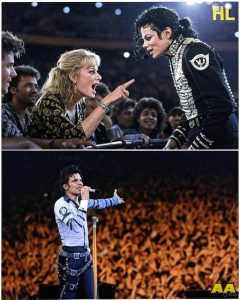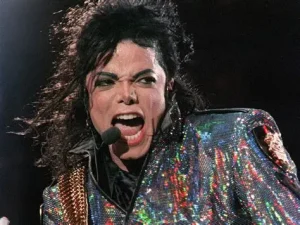A venomous shout cut through the electric air of Ellis Park in 1987, as a woman’s rage targeted Michael Jackson mid-performance. The stadium of 50,000 held its breath, expecting chaos, but the King of Pop met her hatred with a serene smile and words that stunned: “Hatred is learned, Margaret, but it can be unlearned.” His voice, woven with music, dissolved her fury, turning a moment of division into a miracle of unity. Fans watched, awestruck, as prejudice crumbled before their eyes, sparking a wave of emotion that rippled far beyond South Africa. How did one man’s compassion shift a heart and a crowd? The answer lies in a story that still resonates.

How one moment of compassion turned division into unity
A venomous shout cut through the electric air of Ellis Park in 1987, slicing through the rhythm of the night like a dagger. As Michael Jackson spun gracefully on stage, lost in the hypnotic beat of “Man in the Mirror,” a woman’s furious voice echoed from the stands:
“Go home! You don’t belong here!”
For a heartbeat, the stadium of 50,000 froze. The blinding lights, the pounding drums, the synchronized screams—all dissolved into tense silence. South Africa, then a nation fractured by apartheid, was no stranger to division. But no one expected that such raw hatred would erupt in the middle of a Michael Jackson concert.

Security moved quickly, scanning the crowd. Fans gasped, some booed, others simply stared. On stage, the King of Pop stopped mid-step. The music faded. All eyes locked on him. What came next would turn an ordinary night of entertainment into a moment etched forever in cultural history.
Michael stepped forward, the spotlight following him like a celestial beam. Instead of anger, a serene smile softened his face. He raised the microphone to his lips and spoke, his voice calm yet powerful enough to carry to the farthest row:
“Hatred is learned, Margaret,” he said, astonishingly calling the woman by name. “But it can be unlearned.”
The crowd gasped. No one knew how he knew her name. Some whispered it was written on a sign she held, others said security had relayed it to him in seconds. But what mattered wasn’t how—it was what happened next.
Michael extended his arm toward the woman. Not in accusation, but in invitation. His band, sensing the gravity, resumed a soft instrumental—gentle, almost like a prayer. Then, without warning, Michael began to sing again. But this time, it wasn’t just a performance. It was a bridge.
The woman, stunned, lowered her angry sign. Her face crumpled—not with rage, but with tears. The venom had melted away. Around her, fans embraced strangers. Black and white hands intertwined. A wave of emotion swept through the stadium, like a collective exhale after decades of tension.
By the end of the song, she was singing too. Not from the stage, not with a mic, but from her seat, joining thousands of others in a chorus that drowned out hatred with hope.
In the weeks that followed, newspapers called it “The Night Hatred Fell Silent.” Activists and journalists alike wrote about the power of music to transcend politics, race, and fear. For many, it was just one night. But for Margaret—and for countless others—it was the beginning of unlearning.
Michael Jackson didn’t lecture. He didn’t retaliate. He did what he always did best: he reached hearts through melody.
And that night in Ellis Park wasn’t just a concert. It was proof that compassion, when wielded with courage, can silence even the loudest voices of hate.
Leave a Reply